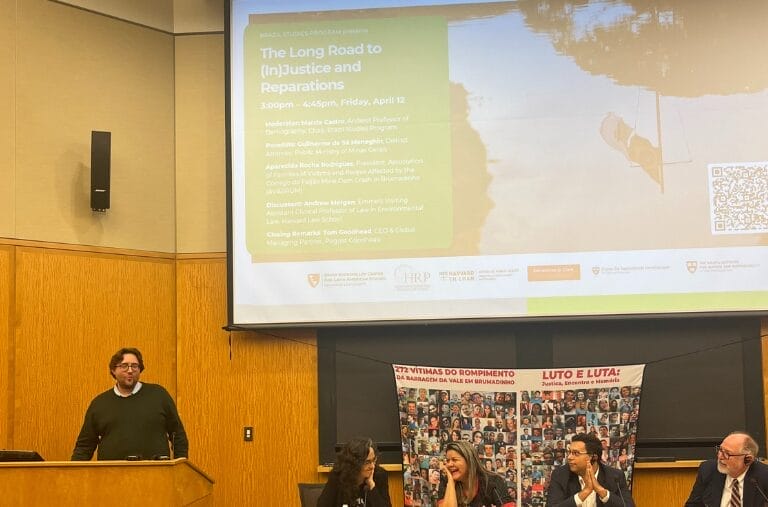In countries with great environmental potential, it is common for natural resources to become one of the main sources of national income through public and private investments. In this scenario, Brazil is a reference nation on the subject: in addition to being one of the countries with the greatest ecosystem diversity in the world, the use of these resources has a considerable effect on the country’s GDP, as it is one of the main zones of economic exploitation.[1]
However, the effects related to the exploitation of natural resources are not limited to the generation of wealth. The merely utilitarian concern for the environment, combined with willful and negligent behaviour based on the impunity of large companies, resulted in a series of tragedies that spread beyond the environment, causing permanent damages to society.
Brazil has hosted a series of environmental disasters of undeniable proportions, most of them caused by direct actions or relevant omissions of large corporations. An example of this happened with the worst labour ‘accident’ in the country: the dam collapse in Brumadinho in 2019.
Although it generated irreversible and absurdly significant effects, this disaster, which must be analysed as a serious offence both from a criminal and civil perspective, demonstrated repeated business (mal)practices. In November 2015, the Fundão dam in Mariana, MG, also collapsed, without even mentioning the dozens of dams that are at current risk of disruption.
Legal Overview
Article 225 of the Constitution is one of the most important of all the provisions of Brazilian legislation on the subject. Besides treating the environment as a guarantee and right of all, it makes explicit the duty of the public power to protect and impose sanctions on those who act against it. To assure such legal protection, preventive and repressive provisions are foreseen by national law.
- Preventive mechanisms aim to avoid damages to the environment by the regulation of predictable dangers, requesting compensation to the performer of an impact action through measures that seek to attenuate, if not extinguish, the damage that will be generated.
- The repressive provisions are, on the other hand, aimed at punishing those who cause environmental damage, besides for acting in a psychological sphere by building up a sense of limit and fear to the business sector, as it brings punishment to degrading conducts.
At an infra-constitutional level, law 6.938/81, which stands for the National Environmental Policy, provides the main definitions, rules, and principles to be followed when attributing civil liability for environmental damages. Such a law attributes strict liability to polluters, which arises from the theory of integral risk applicable to environmental law in Brazil: regardless of the demonstration of intent or the legality of the action, if damage is caused, there is an automatic duty to repair.
Article 3 of such a law conceptualizes the polluter in an extremely comprehensive way, determining that any “individual or legal person, governed by public or private law, directly or indirectly responsible for an activity causing environmental degradation”. Therefore, direct or indirect polluters should be deemed liable as long as the causal link is demonstrated.
On the subject, the Superior Court of Justice has a consolidated understanding that only proof of the causal link between the conduct and the damage is necessary to establish civil liability. The decision of the Justice Rapporteur Min. Herman Benjamin in the Appeal REsp 1071741/SP explains the boundaries:
“12. For the purpose of investigating the causal link in urban-environmental damage and possible joint liability, those who do it, who do not do it when they should do it, who do not care if they do it, who is silent when it is their duty to report it, who finances who do and who benefits when others do.”
The dam collapses in Mariana and Brumadinho – where does the accountability stand?
In 2015, the Fundão mining dam, in the region of Mariana, MG, collapsed. The dam was controlled by Samarco, a joint venture formed by the Brazilian mining company Vale S.A. and the Anglo-Australian BHP Billiton, which acted as tailings for the mining activity.
The tragedy had devastating effects. 39 municipalities were affected by the mud, which deposited ore tailings in almost 700km of rivers in the region.
- 19 deaths were registered
- More than 600 people lost their homes
- The riverside ecosystem disappeared
- The water supply was suspended, among several other irreparable damages caused to nature and the population.
However, it is important to note that the tragedy was foreseen and occurred due to the commissive conduct of the responsible agents. In 2013, a report about the dam was issued manifesting the need for a rupture analysis, a contingency plan in case of accidents and geotechnical monitoring.
Two years later, none of the measures envisaged in the report had been taken and the Fundão dam collapse happened.
As explained, strict liability is applicable in cases of environmental damages, which in itself would generate the obligation to repair by Samarco, jointly with the controlling companies Vale and BHP Billiton.
Moreover, such companies must also respond in the criminal sphere, as wilful misconducts have been verified on several occasions, such as the issuing of the reports, falling at least in the crimes of articles 33, 54 and 69-A of the Environmental Crimes Law.
The Renova Foundation
However, in yet another ratification of the impunity of large corporations, a Term of Transaction and Adjustment of Conduct (“TTAC”) was signed in one of the main Public Civil Actions relating to redress for the harm caused by the collapse of the Fundão Dam, that resulted in the creation of an ‘independent foundation or, as the companies prefer to claim, the Renova Foundation.
The foundation was to oversee carrying out the negotiations and compensations of the victims. Thus, the burden of the damages caused was transferred to a third legal entity, removing the negative repercussions of the responsible companies.
The Renova Foundation only dissipates the direct liability of the polluting companies, in addition to acting in an unsatisfactory manner to those affected. This has resulted in the need for victims to file legal claims in foreign jurisdictions to be able to claim effective redress directly to the parent companies.
After what happened in Mariana, another tragedy of the same nature involving one of the same Brazilian companies took place four years later. The Córrego do Feijão dam, in Brumadinho, also under Vale’s control, collapsed, leaving more than 200 dead and 100 missing, in addition to environmental harm of still inestimable proportions.
With the rupture of the dam in Brumadinho, the disregard for the dam in Fundão became even more evident in the eyes of the public.
Several Parliamentary Inquiry Commissions (CPI) were set up to investigate the matter, with the House of Representatives of Minas Gerais being the most recent and conclusive. It resulted in the subsequent filing of a Criminal Indictment against Vale, TÜV SÜD (German auditing company) and directly involved individuals.
The indictment exposed documents, such as e-mails and WhatsApp messages, which clearly demonstrate the awareness of all of the defendants of the imminent rupture of the Córrego do Feijão dam, and their decision to ‘let it go’.
Need for structural change in Brazil
Given the superficial outcomes that those involved in both dam collapses have faced, and the lack of redress experienced by the victims so far in Brazil, it becomes evident that there is a need for a structural change in the legal system so that institutions can function according to what they propose in a timely manner.
The culture of corporate malpractices, combined with impunity resulting from the inefficiency of the Brazilian judiciary, contradicts the very purpose of Commercial Law, which seeks to optimize business economic activities.
[1] Alice Aloisia Cruz and Elaine Aparecida Fernandes, Relação entre PIB e meio ambiente: abordagem da pegada ecologica (2013) 18 Rev. Des. Regional, Santa Cruz do Sul, 88 – 107








